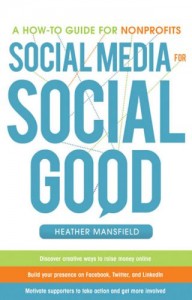So here are a handful of hints, best practices and basic strategies, as compiled from Heather Mansfield’s blog Nonprofit Tech 2.0: A Social  Media Guide for Nonprofits, to maximize the power of Facebook in order to connect with this entire population that is literally, just one click away. Holiday bonus: if you are searching for a special holiday gift for that certain culture vulture or arts manager, consider Mansfield’s recently published how-to guide for not-for-profits titled, Social Media for Social Good. The perfect stocking-stuffer, this comprehensive guide details all the best practices, exemplar not-for-profits and step-by-step instructions (including handy checklists) for building your not-for-profit's online presence and brand- be it a website, an online newsletter, your "Twitter voice," a Flickr account, a YouTube channel, text-to-give technology, tablet applications, etc.
Media Guide for Nonprofits, to maximize the power of Facebook in order to connect with this entire population that is literally, just one click away. Holiday bonus: if you are searching for a special holiday gift for that certain culture vulture or arts manager, consider Mansfield’s recently published how-to guide for not-for-profits titled, Social Media for Social Good. The perfect stocking-stuffer, this comprehensive guide details all the best practices, exemplar not-for-profits and step-by-step instructions (including handy checklists) for building your not-for-profit's online presence and brand- be it a website, an online newsletter, your "Twitter voice," a Flickr account, a YouTube channel, text-to-give technology, tablet applications, etc.
1. Who is the face of your Facebook? Your Facebook page is as good as the social media manager behind it. Creating and maintaining a successful Facebook page (the rewards of which are plenty- Mansfield’s research highlights the direct correlation between the rise of online giving and the rise of social media) depends on the effort and efficiency of the person managing it. Read Mansfield’s blog entry on the 11 qualities of an effective social media manager to be sure your Facebook page is in the best hands possible.
2. Conquer the laggards. Still trying to convince certain skeptical colleagues that this “Facebook thing” is not just a fad? Collect, organize and present to these latecomers the statistics on social media usage (start with a digestible, easy and straight-forward approach, perhaps the video featured above), the trends with rising generations and the shift toward online giving. Still not buying it? Show them what other not-for-profits are doing on Facebook. If you do not join the Facebook community, you are doing your organization a great disservice by becoming less competitive and visible in the not-for-profits sector.
3. You must give some to get some. "Like" other not-for-profit’s on Facebook and engage in activity on their page, with sincerity and moderation of course. Comment on status updates, "like" new posts and respond to news, questions, and comments posted. Not only will you benefit personally from interacting with another not-for-profit and its cause, but by engaging on its wall, you promote your own organization, brand and Facebook page, encouraging Facebook users to explore more about you.
4. Share the love. When updating your own statuses or posting news and comments, be sure to tag any organization you mention (if, and hopefully, they have a Facebook page). This way, your update or post is posted to that organization's wall. Just one more way to put yourself out there…
5. At the bottom of any mass e-mail or automated e-mail response, include a “Like us on Facebook” link to remind your supporters of your presence on Facebook and to give them the opportunity to stayed informed on your progress and activities.
6. Evaluate and adjust. If time after time your posts go “unliked” and your statuses “uncommented,” it is time to consider a different course of action. Facebook is not a newsletter; talk with your followers, not at them. If your Facebook community is not reacting or engaging with the content you publish, evaluate what you are sharing. Is it dead-end content? Does it encourage user feedback? Save the matter-of-fact news for your monthly newsletter and press-releases. Take advantage of Facebook as a community building tool and a platform for exchange.
7. No one likes a Chatty Cathy. Too many status updates and posts per day and that “Hide activity" option on the user's News Feed becomes increasingly attractive.
8. Register for one of Mansfield’s January webinars on successful usage of Facebook and Facebook applications (or check out the other webinars offered on hot topics such as utilizing Google+, YouTube, mobile fundraising, and Twitter).
9. Someone in the office or organization needs a smartphone and needs to be on the mobile web. It does not have to be an iPhone, but in today’s 24/7 streaming news world, it is all about being and staying connected. It is an investment, but one that will be returned as mobile and online giving become the predominant trend.
10. Stay informed. It seems as though Facebook is evolving daily. Do not miss out on the possibilities and potential of the newest features, formats, and most importantly, opportunities for your not-for-profit to expand its reach. Read blogs about the newest changes and innovations in the social media world- a great place to start is right here at Technology in the Arts.
Hope you all had a wonderful holiday!





